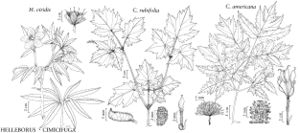Cimicifuga
Gen. Pl., 298. 1763.
| Taxon | Illustrator ⠉ | |
|---|---|---|
 | Cimicifuga americana Cimicifuga rubifolia Helleborus viridis | John Myers John Myers John Myers |
Herbs, perennial, from hard, knotted, long-lived rhizomes. Leaves basal and cauline, compound, petiolate with basal wings clasping stem; cauline leaves alternate. Leaf-blade 1-3-ternately compound; leaflets ovatelanceolate to broadly obovate or orbiculate, 2-5-lobed, lobe margins toothed or shallow to deeply incised. Inflorescences terminal, many-flowered panicles of racemelike branches [spikes in Asian spp.], 7-60 cm; bracts 1 or 3, alternate, subtending pedicel (pedicels bracteolate in C. americana), not forming involucre. Flowers bisexual [unisexual], radially symmetric; sepals not persistent in fruit, (2-) 4-5 (-6), greenish white or cream to greenish yellow, sometimes pinkish or tinged with red, plane or ± concave, ovate to obovate, 3-6 mm; petals 0-8, distinct, white or yellowish, plane, apex 2-cleft [entire], sometimes clawed, 3-6 mm; nectariferous area sometimes present; stamens 20-110; filaments filiform [flattened]; staminodes absent between stamens and pistils; pistils 1-8, simple; ovules 4-15 per pistil; style present. Fruits follicles, usually aggregate, sessile or stipitate, ovoid to obovoid, weakly to strongly compressed, sides not prominently veined; beak terminal, straight or hooked at tip, 0.5-2.5 mm. Seeds pale-brown to reddish or purplish brown, angled or laterally compressed, hemispheric, lenticular, or cylindric, smooth, slightly ridged, verrucose, or densely scaly. x = 8.
Distribution
North America and Eurasia
Discussion
Species 12 (6 in the flora).
Cimicifuga may be divided into two natural groups: those with seeds scaly and those with seeds lacking scales or nearly so. Cimicifuga racemosa and C. elata of North America, with scaleless seeds, are most closely related to C. biternata (Siebold & Zuccarini) Miquel and C. japonica (Thunberg) Sprengel of Asia.
Four or five species of Cimicifuga are cultivated as ornamentals, and at least five named cultivars have been developed.
Selected References
None.
Lower Taxa
Key
| 1 | Seeds without scales or scales very short; stigma 0.5 mm wide. | > 2 |
| 1 | Seeds scaly; stigma minute, 0.2–0.3 mm wide. | > 3 |
| 2 | Follicles ovoid; seeds hemispheric, smooth or ±rough-ridged, brown; pedicel subtended by 1 bract; base of terminal leaflet with 3 prominent veins; petals (1–)4(–8), oblong; e North America. | Cimicifuga racemosa |
| 2 | Follicles oblong; seeds lenticular, usually verrucose, rarely with very short scales, reddish to purplish brown; pedicel subtended by 3 bracts; base of terminal leaflet with 5–7 prominent veins; petals absent; w North America. | Cimicifuga elata |
| 3 | Pistils sessile, 1–2(–4 in C. arizonica); seeds lenticular, covering of scales giving cylindric appearance. | > 4 |
| 3 | Pistils short-stipitate, (2–)3–8; seeds lenticular, scales not causing cylindric appearance. | > 5 |
| 4 | Petals absent; filaments 3–5 mm; pistils 1(–2), sparsely glandular; style short, straight or slightly recurved; terminal leaflet deeply cordate with 5–9 prominent veins at base; e North America. | Cimicifuga rubifolia |
| 4 | Petals (0–)2; filaments 5–8 mm; pistils 1–3(–4), glandular; style long, hooked; terminal leaflet somewhat cordate with 3 prominent veins at base; w North America. | Cimicifuga arizonica |
| 5 | Pistils glabrous; pedicel bracteolate, granular; petiole glabrous; seeds ca. 3.5 mm, covered with broad, lacerate scales; stamens 40–70; filaments 6–10 mm; e North America. | Cimicifuga americana |
| 5 | Pistils densely pubescent; pedicel not bracteolate; petiole densely pubescent; seeds ca. 2.5–3 mm, loosely covered with narrow, lacerate scales; stamens 20–25; filaments 4–5 mm; w North America. | Cimicifuga laciniata |